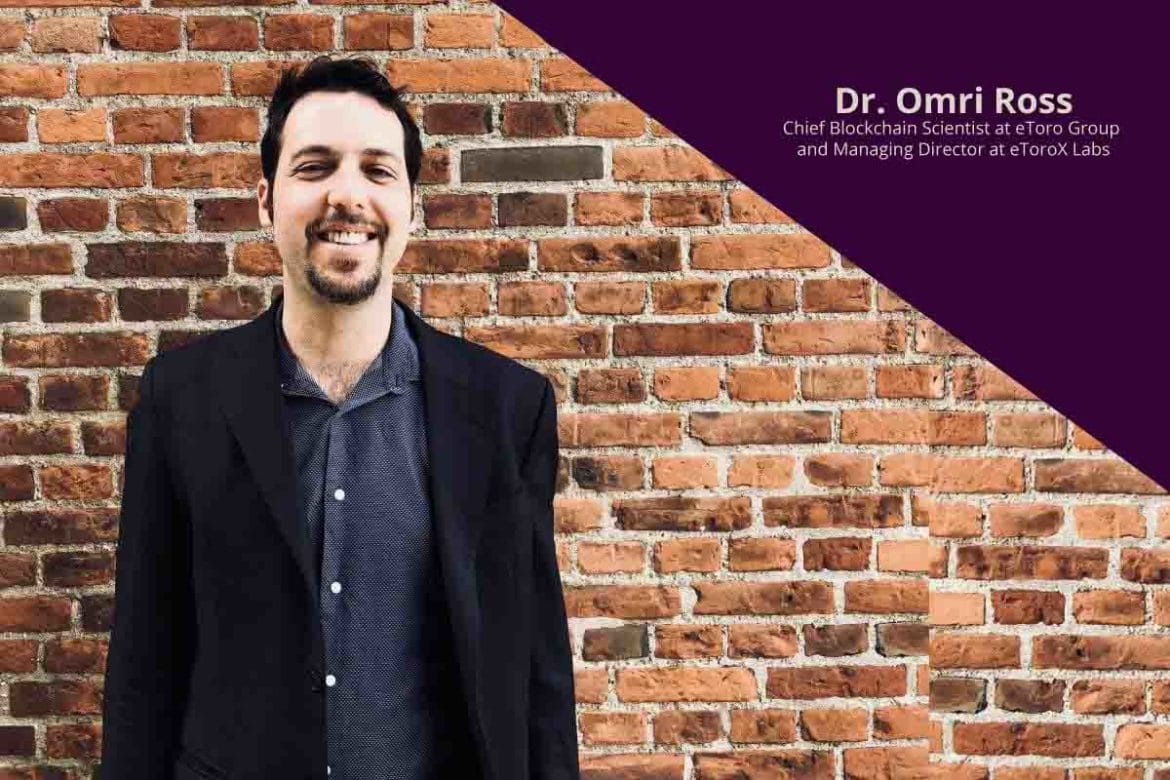
Omri Ross interview eToro
Chief Blockchain Scientist at eToro Group and Managing Director at eToroX Labs Omri Ross has stated traditional banks joining the crypto sector have compliance and KYC as their primary concerns. In a recent exclusive interview with Buy Shares, Ross acknowledged that as time goes by these concerns these concerns are gradually dissipating.
On the concerns surrounding the centralization of Facebook’s Libra, Ross commended the social media platform for taking the right steps to win the trust of users. Furthermore, the blockchain scholar highlighted how the traditional financial system can take advantage of the Lira project by eToro.
On having a consolidated universal syllabus for the crypto sector, Ross highlighted some of the positive developments in the sector and obstacles towards achieving a globally accepted curriculum.
As a scholar in the Blockchain sector, what do you think is the stumbling block towards having a universal crypto syllabus?
Universality and standardization are integral to advancing the industry as a whole and promoting the integration of blockchain applications in addressing different markets and use-cases. However, diversity and a degree of fragmentation is to be expected in emerging industries and can, in some instances, promote creativity and entrepreneurship.
From the academic perspective, I think it will be a while before the many complex activities in this sprawling industry will consolidate around a universal syllabus. In fact, as the technology is adapted in a variety of use-cases, I find it more probable that terminology will emerge around the individual use-cases, whereas the underlying protocols will take a backseat, similar to how we speak of the internet today.
Blockchain technology has been around for about a decade now. Can you comment on the technology’s evolution and the future it holds in terms of unexplored opportunities?
Blockchain technology and the general wave of innovation in financial infrastructure associated with permissionless infrastructure is still in its infant stage. Just like the internet, at the time, the evolution of these technologies is intrinsically linked to broader socio-economic development, which tends to run at its own pace.
While it was arguably possible to construct a working e-commerce site already in the mid-nineties, it is only much later that companies like Amazon, Facebook, and Netflix have come to exercise the degree of socio-economic impact we associate with these organizations today. It also took some time to achieve maturity of the stack to offer the experiences we expect from websites or mobile applications today, as well as building mature business models to monetize the technology. Similarly, while the design space for permissionless deterministic computation may radically change existing business processes, it is nearly impossible to predict how and when this will happen. However, due to the potential in terms of transparency and censorship resistance, I personally believe that technology and its usage will grow exponentially in the coming years.
I believe that the qualities associated with automation and transparent computation will emerge as an attractive solution for redesigning existing business models in the future. This is simply because of the cost-effectiveness and accessibility associated with utilizing permissionless blockchain technology as the base layer of the stack in any financial application. We have recently seen multiple interesting innovations in the asset exchange and liquidity provision currently led by Compound, Uniswap, and new DeFi concepts such as Curve or Balancer. I will be looking forward to a similar wave of first-movers in the insurance industries, supply-chain industries, and beyond.
What stands in the way for traditional banks from offering crypto-related services to users?
The primary issue for regulated institutions is generally securing compliance with mandated AML and KYC regimes when offering custodial or trading related services with digital assets. While a frequently recurring topic of the past five years has been concerns related to the suitability of the existing regulatory regimes and the integration of digital assets with legacy infrastructure, these roadblocks appear to be gradually dissipating.
The best example of this development is the introduction of cryptocurrency wallets and operators to MLD5, set out by the European Commission. As a result, banks of all sizes are now eyeing an entry as providers custodial services for digital assets. Considering the recent studies by Fidelity, which indicate that a third of large institutions own crypto assets and general data indicating a growing segment of digital asset users, my assumption is that the number of traditional institutions working towards a crypto-asset offering is likely to increase, in the coming years.
What does the future hold for CBDCs? And is there a chance that Central Banks will classify CBDCs as cryptocurrencies?
It has been fascinating to observe the rapid growth of activities in the CBDC space, largely triggered by the release of Lira and the immediate announcement of a blockchain-centered strategy by the PBOC. At present, it appears that a race towards monetary supremacy is forming around the capacity for rapid development and implementation of DLT architecture. Certainly, the degree to which the technology is now poised to exercise geopolitical impact is set to rapidly accelerate the pace of innovation in this space. I do not believe that central banks will classify CBDCs as cryptocurrency, rather, it appears that the vast majority of actors in the space will simply produce a digital version of existing domestic currencies.
The Libra foundation recently released version 2.0 and eToro has pointed out that the latest changes are less open, and less decentralized. In your opinion, what should Facebook do to alleviate any fears that the project will be centralized?
With the second release of the Libra project, the Libra Foundation has taken several initiatives to address concerns aired by regulators and government officials. The foundation has proposed new solutions both in the protocol design but, similarly, through a careful re-evaluation of the launch strategy and selection of participants.
We see this as a significant step in the right direction and I am confident that the Libra Foundation will continue to win the trust of their customers and regulators across jurisdictions, leading to a successful launch.
Cryptocurrency exchanges continue to experience security breaches despite advanced technology to secure customer funds and personal details. How does eToroX guarantee customers about the safety of their details and funds?
At eToroX, our primary concern is the safety and security of our clients and their funds. As one of the few fully regulated professional crypto-asset exchanges in the world, we have the fortune of offering our clients a best-in-class security architecture. As part of the eToro Group we combine the stability of a market-leading financial services provider with the security and transparency of a regulated crypto powerhouse.
How has a lack of a well defined regulatory framework impacted eToroX operations? And what do you think is the way forward towards having a standard global cryptocurrency regulation?
We take great pride in the fact that eToro is one of the first companies in the world to obtain a distributed ledger technology license for crypto assets from the Gibraltar Financial Services Commission, making us one of only a handful of regulated companies in the crypto space. eToroX is regulated under the authority of the GFSC (Gibraltar Financial Services) which, back in 2018, was one of the 1st jurisdictions to present a framework for regulating DLT providers. The GFSC has adopted a supple approach in which regulatory outcomes are considered essential but achieved primarily through the application of principles, rather than a rigid set of rules. For businesses operating with rapidly evolving technologies such as blockchain or DLT, rigid or premature regulation may quickly become unfit for purpose and fail to produce the intended level of compliance.
eToro is already developing a stablecoin, what gaps currently in the market that this stablecoin will address and also how it operates?
There are multiple interesting strategic opportunities for stablecoin models emerging on a continuous basis. Using the eToken, traders can diversify their portfolio amongst a host of stablecoins linked to underlying commodities, fiat currencies, and other cryptos. Given the global nature of the crypto-markets, we are able to offer our traders 24/7 FX trading opportunities on eToroX all year round.
The eToken standard was developed to provide clients direct access to a host of liquid trading pairs in fiat currencies, which has so far enabled our users to trade crypto across multiple pairs of currencies and commodities. With the eToken, our users will be able to settle transactions in any currency format across in a variety of blockchain native applications, such as options, futures, or interest swaps written in Lira contracts.
The Lira project by eToro seeks to lower risks involved in settling financial contracts. How can the traditional financial system leverage this domain-specific language?
The Lira project consists of a domain-specific language for writing OTC contracts. Using the language, traders can write and deploy the vast majority of financial derivatives, entirely for free. I invite anyone interested in settlement and clearing of financial contracts to have a look at the language on: https://demo.lira.org/
The traditional financial system can leverage the Lira project and the associated findings to realize cost-savings by executing derivative contracts on-chain. By reducing dependencies on the host of intermediary service-providers in the post-trade cycle, institutions can execute financial contracts for clients facing a heavily reduced cost-profile.
